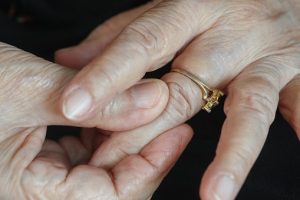 Bouchard’s nodes are finger deformities that affect the fingers and are often found in people who have osteoarthritis. While these nodes may not be painful, they’re often associated with limited motion in the affected joints.
Bouchard’s nodes are finger deformities that affect the fingers and are often found in people who have osteoarthritis. While these nodes may not be painful, they’re often associated with limited motion in the affected joints.
The most straightforward Bouchard’s nodes definition is bony enlargements at the middle joint of the fingers, which are called proximal interphalangeal joints. These joints provide an important function – they allow the fingers to flex towards the palm of our hands. Bouchard’s nodes are named after French pathologist Charles-Joseph Bouchard who first described the bony enlargements in the nineteenth century.
Advertisement
Heberden’s and Bouchard’s nodes are sometimes confused since they’re both finger deformities that can be seen in people who suffer from degenerative joint diseases. However, the difference is that Heberden’s nodes form in the joint closest to the fingernail.
This joint is called the distal interphalangeal joint. Bony bumps can also occur at the base of the thumb and form at the carpometacarpal joint (CMC). The name derives from the bone of the wrist (carpal) and the bone of the thumb (metacarpal).
Also read: Thumb arthritis & pain: Causes and treatments
What Is the Significance of Bouchard’s Nodes?
If you still aren’t quite certain where the joint associated with Bouchard’s nodes is located, take a ring and start putting it on your finger. The joint involved is the one just above where the ring sits. It’s the toughest joint to get past when you slip a ring on or off.
It’s been suggested that the nodes are inherited, and many medical researchers believe they’re the result of osteophytes. Osteophytes are a bony outgrowth that has been linked to degeneration of cartilage. There are some in the medical community that aren’t 100 percent convinced that nodes and osteophytes are linked.
Despite what side medical experts are on, when it comes to osteophytes, most agree that genetics plays a role in forming osteoarthritis, which is general wear-and-tear with aging or the result of an injury to a joint. Usually, by the time you can see Bouchard’s nodes, osteoarthritis has progressed.
Also read: Shoulder bone spur: Causes, symptoms, treatment and exercises
What Causes Bouchard’s Nodes?
Bouchard nodes’ cause degeneration of the cartilage. Osteoarthritis is linked to degeneration of cartilage. Cartilage is a connective tissue that covers the end of bones. It protects and prevents bones from rubbing against each other but degeneration of the cartilage can start to wear away and the bones can get damaged due to friction. The body reacts by creating extra bone tissue on the edges of the bone. Pain occurs when the bony enlargement starts to encroach surrounding tissue.
Most rheumatologists will tell you that Bouchard’s nodes are a classic sign of hand osteoarthritis.
There are situations whereby trauma or injury can lead to bony outgrowths. While this is more likely on the heel of the foot or the knee, it can happen to the fingers as well. For example, some athletes that are otherwise healthy have experienced Bouchard’s nodes.
Treating Bouchard’s Nodes
Bouchard’s node treatment depends on the severity of the condition and how much pain the patient is experiencing. In some cases, there is no pain. If there are symptoms of pain, stiffness, inflammation, and immobility, the following approaches can be considered:
- Mild painkillers: Over-the-counter medications or prescribed medications
- Heat and ice: This is a therapy that is usually helpful when the nodes are first formatting.
- Physical therapy: This can help address stiffness and help a sufferer maintain good range of motion.
- Non-steroidal anti-inflammatory medications: To address swelling and inflammation.
- Cortisone injections: This is a corticosteroid and a local anesthetic injected right into the affected joint.
- Disease-modifying anti-rheumatic drugs: To help those who have the underlying condition rheumatoid arthritis.
- Surgery: Various approaches used if the interphalangeal joint is severely affected by osteoarthritis.
If surgery is recommended, the goal will be to help the patient regain some range of motion and alleviate discomfort. In some cases, nodes are removed during an operation. Arthroscopy allows for a minimally invasive approach.
Another procedure called arthrodesis can fuse together the ends of the bone joint. Arthroplasty is used to replace the affected joint with an artificial one. Artificial joints are more suitable for older individuals but tend not to last as long in younger, very active people.
Advertisement
No matter what the age of onset of Bouchard’s nodes, the earlier the condition is treated, the better the chances of recovering the range of motion. We also want to point out that surgical treatment is not usually carried out for cosmetic reasons. Once the nodes appear, we know that the joint has already degraded and is unlikely to look exactly like its pre-node state.
Living with Bouchard’s nodes can be challenging due to lack of motion and due to the appearance of the fingers; however, there are steps you can take to minimize the frustration. For example, you can avoid straining the fingers, use hot water to help open jar lids, and use both hands when lifting objects like pots and pans. Learning to manage the condition can mean you will be able to have a more active and independent life.
Also read:
- Bone Spur in Knee: Causes, Symptoms, and Treatment
- Bone spurs in neck: Causes, symptoms, diagnosis, treatments, exercises, and natural remedies
